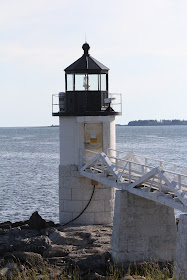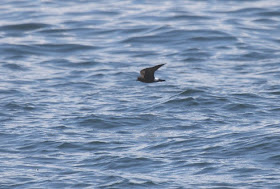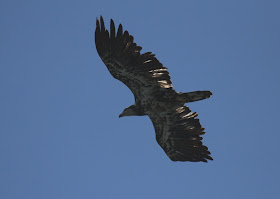Part 1-
The Red-billed Tropicbird and an Isolated Island off the Maine Coast
When you hear that a Red-billed Tropicbird has been seen every summer for the last few years off the coast of Maine Maine New England seabirders, we envision a summer pelagic trip to Hatteras to have a reasonable chance to see this magnificent seabird or its cousin the White-tailed Tropicbird. But as many birders have discovered, a single Red-billed Tropicbird has been spending the summer on an isolated island twenty-one miles off the coast of Maine
The Tropicbird was first discovered in 2004 at Matinicus Rock, and then seen briefly at Seal Island Maine island of Vinalhaven which is twelve miles off the coast of Rockland Rockland
The trip ends at the town docks in Carvers Harbor Maine Seal Island
I had wanted to see and experience this bird for two years, but Jen and my summer work schedules never worked out; until this year! We made our plans earlier this year and everything fell into place. I contacted John in early April and made plans with him. He would contact me if (hopefully when) he spotted the Tropicbird on Seal. On May 13, I received a wonderful email from John; the Tropicbird was back! John spotted it the day before when the bird flew by him and landed in its burrow. I privately chartered John for two days, and we decided that staying on Vinalhaven for four days would be best just in case the weather was acting up. Having four days set aside (as insurance) to go out twice made perfect sense to me. John mentioned that the Tropicbird was seen in the afternoons, so we decided to meet on Sunday afternoon the same day we would be arriving on Vinalhaven. In our email conversations, I mentioned to John that I would like to float a few of my alcid decoys to see if we could attract the birds to them. I would be bringing Puffin, Razorbill and Murre decoys with me, and I had plans to carve a Black Guillemot and a Red-billed Tropicbird as well. John said, “Sounds like fun”- “bring them along”! Now I was really anxious, all Jen and I had to do was wait until late July!
The Black Guillemot decoy-
The Black Guillemot is a favorite alcid of mine. Along with the Razorbill, I have seen them in every coastal state of New England . I am especially fascinated with their seasonal dimorphic plumage; black in the summer, white in the winter. The decoy carved, sealed and ready for paint-
To keep the decoy authentically “Maine
……and the bottom plate wood is Black Walnut and the carved keel is White Oak which I also purchased from a Maine
The painting begins by painting the feathers in the tail, dorsum, lower tail coverts and primaries-
The tertials and secondaries are now painted-
The white greater, lesser and medial wing coverts are painted-
Next are the scapulars and side pockets-
And finishing the chest and head-
The finished Black Guillemot decoy ready to float in Maine-
Saturday, July 21, 2012- Excited that the day had finally arrived, Jen and I left early Friday morning (3:30 am) and headed north. We spent the day making business appointments in Maine
( http://www.islandviewinnmaine.com/ ) we made a quick run to one of our favorite New England towns Port Clyde before sundown.
Marshall Point Lighthouse-
The charming town is where you can take the ferry to Monhegan Island
( http://monheganboat.com/), or one of the Nature Cruises through the islands including the Puffin cruise. Jen and I decided to take the morning Puffin Cruise, so we made reservations.
We arrived to the ferry dock at Port Clyde, and soon we were boarding the Laura B for the 11:30 am departure. While we were sitting on the bow seats, Jen looked over and spotted this hen Eider sleeping on a floating platform. With the hen were two ducklings which were about ten days old. When the Laura B cast off its lines, the three birds slipped into the water and swam off.
As we steamed out of the harbor, the first Black Guillemot flew by the bow-
The crew of the Laura B maintains working Lobster traps as part of its cruise agenda. They stop for a few minutes and tend their traps; hauling, culling thorough the Lobsters, tossing back any bi-catch, refreshing the bait bags, and tossing the traps back overboard. Although we were both familiar with this (Jen used to work on her Dad’s Lobster Boat), we still find it fascinating to watch.
As they were attending their pots, Jen looked up and spotted a distant Bald Eagle flying in from the outer islands.
Passing by the Marshall Point Lighthouse…..
…..gulls surrounded the Lobster boats waiting for a free handout of tossed over bi-catch or old bait-
Crossing the outer bay towards the islands, a small pod of (unknown) Porpoises or Dolphins broke the surface-
As we passed through the outer islands, Phil the naturalist told us wonderful tales and history surrounding the islands and their inhabitants. Black Guillemots were just about everywhere you looked…..
….. as were Common Eiders with their ducklings!
A single Barn Swallow crossed by the bow-
Off in the distance was Eastern Egg Rock, known as the “World’s first restored Puffin Colony”- (http://www.projectpuffin.org/EasternEggRock.html ) -
The last mile and a half stretch to Eastern Egg Rock was highlighted by many Black Guillemots, and the first of the Wilson
The first Puffin appeared from the southwest crossing the by the bow of the Laura B at a distance…..
….. and a second one flew over the northeast corner of the island as we approached.
As I was photographing the Puffin, a Black Guillemot flew by heading for its nest burrow……
…..and disappeared inside.
Looking at the top of the island, there were many Puffins standing with the “decoys” on the boulders with a few Common Terns and Laughing Gulls-
A pair of Puffins swam close by the bow of the vessel offering good views-
More Puffins on the top boulders-
This Guillemot is returning with a food item; a Rock Gunnel (thanks to John who later identified it for me)-
More Black Guillemots-
The eastern side of the island had larger concentrations of Puffins. They flew by…..
…..and swam by in pairs, singles…..
…..and small groups-
This adult is returning with a large Herring-
Common Tern-
Laughing Gull-
Common Tern also with a large Herring-
This Black Guillemot “popped-up” in front of Jen and me only a few yards off the bow. It had caught a brilliant red Rock Gunnel (Pholis gunnellus) which beautifully complimented its bright red gape and tarsii. I had always called this fish a “Rock Eel”. I was curious to the actual identification of this fish, so later when John looked at these images in my camera he identified it for me.
Another Black Guillemot with another unidentified fish prey item…..
…..interesting shot; it takes a fish and leaves a little something behind!
Close fly-by Black Guillemot-
The vessel made one slow circle around Eastern Egg Rock , and then headed back towards Port Clyde. I would have enjoyed a little more time at Eastern Egg, but since we would have two days at Seal Island
……on the crossing to Seal Ledges, appropriately named for the many Harbor Seals that loaf and congregate there-
Double-crested Cormorants……
…..and Common Eiders visit with the Seals-
The Laura B then passed through the Reach between Davis and Thompson Islands to see the two Osprey nests on Davis-
This pair of Ravens also found Davis Island
The ledges of Hart Island
“Look”- “No Gulls”!-
Well, we all know that wouldn’t last long!
As the Laura B pulled into the dock, this juvenile Bald Eagle flew overhead-
The three hour tour (although not nearly long enough) was a good time. We learned quite a bit about the history of the Islands , and did see quite a few birds.
Here are the highlights for Saturday, July 21 (estimated)- 65 Common Eider, 9 Wilson’s Storm-Petrel, 3 Northern Gannet, 50 Double-crested Cormorant, 1 Great Cormorant, 7 Osprey, 3 Bald Eagle, 45 Laughing Gull, 200 Common Tern, 35 Black Guillemot, 40 Atlantic Puffin, 2 Common Raven, and 1 Barn Swallow (Herring and G B-b Gulls were present in large numbers- I didn’t count them).
After a late lunch, we drove back to Rockport, but made a few stops in Rockland
Later in the day we just sat back and relaxed on the deck of the Island View Inn which had a great view of Glen Cove
Port Clyde (red arrow) and Eastern Egg Rock (orange arrow)
Black Guillemots seemed to prefer the western shore of the Island (orange arrow) and Puffins seemed to prefer the eastern shore of the Island (red arrow)
Day 2- July 22, 2012, Heading to Vinalhaven- As I mentioned earlier, the trip to Vinalhaven is a bit challenging IF you are planning on taking your vehicle!
The Rockland/Vinalhaven ferry slip-
Difficulties have solutions!- Keeping in mind, if you plan ahead and are a bit “creative” everything will work out, and it will be extraordinarily worth it!!
(Difficulty #1)- Lodging. -There is only one Motel (the Tidewater Motel- http://tidewatermotel.com ) on Vinalhaven, and two B&B’s. Unless you are planning on renting a house or cottage (if available) you will have to make reservations well in advance.
(Difficulty #2)- the Ferry. -Since it is a small ferry, with limited space (seventeen vehicles) and because of that very limited space it is very difficult to obtain reservations if you are taking your own vehicle. Vehicle reservations are almost impossible to obtain in the summer and if you are planning on taking your vehicle across, it is required that you make your reservation exactly 30 days prior to crossing. Keep in mind that reservations are given on a first-call, first-served basis, and Islanders have priority! As I mentioned above, you can walk over on the ferry, and the walk to the Tidewater is only a short distance. A rental car is just about non-existent, so if you plan on staying on the island for a time period to explore, transportation is essential!
We were extremely fortunate to have acquired round-trip reservations, and due entirely to the ferry courtesy offered by the Tidewater. Phil and Elaine Crossman the owners of the Tidewater have set up a very accommodating ferry reservation system for its guests. They have a “ferry-fairy” who holds places in line at the ferry parking lot to hold vehicle positions in line for the crossing. After the reservation arrangements have been made by the Tidewater on your behalf. All you have to do is just be there early and trade places with Beth. She pulls her car out of line, and you take her place. The reservation tickets are sent to you from the Tidewater in advance which secures your reservation and place in line. :^)
(Difficulty #3)- the Weather. – you can never predict the weather; even sunny days can give you a false sense especially if it is breezy, let alone windy. Remember, Seal Island
If you plan ahead, even these difficulties can be overcome making your sea birding experience the best! Jen and I are putting together and planning a trip next year with John (and hopefully the Tropicbird). He can take seven people on his vessel, so we will have openings for five others. I will discuss this more at the end of this long report.
The Ferry pulled out of Rockland Harbor Wilson
When we reached Lawrys Narrows at the entrance to the Fox Islands Thoroughfare, I noticed that something had disturbed all the Gulls that had been roosting on Cedar Island
…..my suspicions were verified as an adult Bald Eagle was being escorted away from the Island .
On nearby Harbor Island
In the coves near Dyer Island
Black Guillemots could be seen just about every direction we looked-
Common Tern-
Common Eiders dotted the seascape. Many eclipse drakes were seen in the flocks…..
…..as this isolated drake sleeping on a tidal rock-
Osprey flew back and forth across the Thoroughfare-
As Carvers Harbor
We were greeted by this Laughing Gull-
The Tidewater Motel viewed from the Harbor-
The Rockland/Vinalhaven Ferry (viewed from Lanes Island
The ferry docked, and we disembarked. We turned right and drove towards the hotel
(a few hundred yards). Near the ferry slip were a few dockside shops; café’, pizza restaurant, general store, lobster coop, gas pump, and a salon. Downtown Vinalhaven was everything we expected; it was timeless and extremely charming!
In town there are a few restaurants, a bakery, grocery store, a few variety stores, spirit shop, ice cream shop, Post Office, and the Tidewater Motel. Everything you needed for a short or long stay was here! It was obvious that Vinalhaven’s main industry was lobstering; judging by the quiet harbor filled with lobster boats. In Fact, Vinalhaven is Maine
We checked into the Tidewater, and the room was really cozy, complete with kitchenette, stunning harbor views, and an amazing cool ocean breeze; we had come to the perfect place! But the best part about the Tidewater besides the spectacular view was below us- from the Tidewater website:
“The Tidewater Motel is built on a bridge. The ebb and flood of the tides flow directly below your room. The same rush of the open water once powered a blacksmith shop, a granite polishing and grist mills on the site. Carvers Harbor
Low tide-
The Harbor views from the deck-
Fox Island Thoroughfare/Vinalhaven/Carvers Harbor- Bald Eagles (orange arrows), feeding Common Tern flocks (green arrow), Tidewater Hotel at Carvers Harbor-
Part 2 Continues……..Meeting John Drury and the Red-billed Tropicbird-
just click on “Older Posts” below on the right-
just click on “Older Posts” below on the right-






























































































































































